インタビュー(9)太田幸夫さん:Interview with Mr. Yukio Ota [インタビュー]
インタビュー:太田幸夫さん(太田幸夫デザインアソシエーツ代表、多摩美術大学教授、NPO法人サインセンター理事長)
Interviewee: Mr. Yukio Ota (Chief, OTA Yukio Design Association, Professor, Tama Art University, and Chairman, NPO Sign Center)
太田幸夫さん 目黒区平町の自宅で:Mr. Ota at Home in Taira-machi, Meguro
4月25日(金)に、都立大学駅の近くにある太田幸夫さんのご自宅に招待されて、色々とお話しをうかがうことができました。まずは、素敵なデザインの家具や美しい色や形の陶器が目に入ってくる家の中をご案内いただき、さらに手慣れた作法で美味しいお茶まで立てていただきました。その上で、代官山やヒルサイドテラスについてのご意見をお聞きしたのですが、太田さんは言うまでもなく、今や世界標準となったあの非常口のサインをデザインされた方で、長い間グラフィックデザインやサインの国際標準を確立することに貢献してこられたことはよく知られています。
太田さんのお話しは、まず1970年代初めに慶応幼稚舎の創立100周年を記念した新しい図書館のサイン計画にかかわったことから始まり、そのことが朝倉さんや岩橋さんとのかかわりを通じて槙文彦氏の設計されたヒルサイドテラスの開発に参加するきっかけになり、粟津潔氏の後を受けてヒルサイドテラスのサイン計画を担当することになったとのことでした。たまたま太田さんはそのころ、つまり70年代中ごろ、沖縄海洋博覧会の色彩調査やサイン計画にかかわったこともあり、ヒルサイドテラスの建物の色とテクスチュアを沖縄の珊瑚からできた砂浜の砂のような深みのあるものに感じたため、ヒルサイドテラスが東京砂漠の中にある「オアシス」になるようにという願いを込めて、当初マリーンブルーを多く使われたという(ただし、最近の改修で建物の色が変わってしまったのは残念とのこと)。それから30年以上経った先日4月18日のヒルサイドセミナーの「都市を語る」の対談で、槙文彦氏が「都市にはオアシスが必要」と述べたのを聞かれて本当に嬉しかったとのことでした。
さらに、ヒルサイドテラスは、住居、商業、オフィスの三つの活動がほぼ同じ比率で共存する複合性と多様性があり、また周辺住民のためにさまざまなイベントや展覧会や演奏会などが開催されるオープンでパブリックな空間を持つような「町」ないし「コミュニティ」として機能していることを強調。そしてヒルサイドテラスに見られる低層な開発は、建物の直線的な稜線がその横にある樹木の枝の有機的な形によって和らげられ、素晴らしい効果を上げることのメリットも指摘されました。
太田さんがさらに主張された重要な点は、ヒルサイドテラスの基準は特別視されるべきなく、もっとさまざまなプロジェクトで「平均的な標準」として受け入れられるようにならなければいけないとのこと。その意味で、ヒルサイドテラス以外の代官山の開発やデザインについては、もっと改善する余地があるとして、一つの大胆な提案をされました。
それは、ヒルサイドテラスの生みの親である槙文彦氏を中心とする「まちづくり委員会」を結成し、代官山のすべての開発プロジェクトの計画は事前にその委員会に届けられ検討されるようにして、できるだけ槙氏のアドバイスを得て望ましい方向に改善されるようにしたらどうか。そうすれば、代官山のアイデンティティが内部的にも外部に対してもより明確になり、それに同意する人たちだけが集まる町に代官山がなっていって、望むらくはそのような過程を経て、代官山の町全体が渋谷、恵比寿、中目黒といった周辺地域に望ましい影響を及ぼすようになると、太田さんは考えられています。
実はお会いする前は、太田さんがもっぱらサインのデザインといった分野で貢献された点についてだけ話しをされると予想していて、幅広い視点から代官山の町づくり全体についてこれほど「熱く」語られるとは思ってもいなかったので、ある意味で驚きでした。しかし太田さんの言われたことを後でじっくり思い出して消化してみると、太田さんのサインやデザインについてのコンセプトは非常に広い意味を持ち、ヒルサイドテラスそのものが望ましい開発のサインやデザインであり、また同様に代官山の町全体が今後はより広い地域にとって望ましい町づくりのサインやデザインになるようにすべきと主張されていたことに気づいた次第です。
参考:References
「太田幸夫多摩美術大学教授:Innovative One インタビュー」:
http://www.innovative.jp/interview/2006/0125.php
「ヒルサイドテラス:History, Chronology」:
http://www.hillsideterrace.com/history/chronology.html
ヒルサイドテラスの初期の壁に似た色の陶器を探す太田氏
Mr. Ota showing desirable color
Interview with Mr. Yukio Ota
I was invited to Mr. Yukio Ota’s residence near Toritsu-Daigaku station on April 25. Mr. Ota showed me around in his home with nice furniture and potteries, and then served me traditional green tea before explaining his opinions on Daikanyama and Hillside Terrace. He is well known for his creation of the emergency exit sign design, which has become a world-wide standard, and for his participation as a Japanese representative in the ISO committee on graphical symbols.
Mr. Ota said that his involvement in sign planning for a new library at Keio Gijuku Yochisha in commemoration of its 100th anniversary in the early 1970s led him to the Hillside Terrace project through his acquaintance with Mr. Asakura, Mr. Iwahashi and others at Keio. He succeeded Mr. Kiyoshi Awazu as the sign designer for Hillside Terrace under the leadership of designer Mr. Fumihiko Maki in the 70s and the 80s. Mr. Ota, who was involved in the Okinawa Ocean Expo in the mid-70s, came up with the idea of using "marine blue" to reflect Okinawa’s beach sand color for the façade of Hillside Terrace, which should become an “oasis” in the middle of the Tokyo desert (unfortunately, the color was lost due to recent renovations). Mr. Ota said he was so glad to hear, after thirty some years, that Mr. Maki mentioned the necessity of an "oasis" in a large urban area at the Hillside seminar on April 18.
It was also pointed out that Hillside Terrace possesses necessary ingredients for a functioning community such as complexity and diversity by accommodating residential, commercial and office activities in almost equal proportions, as well as openness and publicness by providing semi-public space for various events, exhibitions and performances for community members. Furthermore, he emphasized the merits of low-density development in that physical structural lines are softened by the organic shapes of nearby trees and plants, as can be observed in the case of Hillside Terrance.
Mr. Ota argued that the standards set by Hillside Terrance should not be considered exceptional, but be more widely accepted as “average” standards for various projects. In this regard, there is much room for improvement in planning and designing the rest of Daikanyama outside Hillside Terrace. He went so far as to propose a “town committee” system, where all project plans in Daikanyama should be submitted to obtain suggestions for improvement from Mr. Fumihiko Maki, mentor for the Hillside Terrance project. That way, Daikanyama’s identity would become much clearer within as well as outside the community, so that only those who agree with it might be attracted to Daikanyama. Hopefully, through such a process, the city of Daikanyama as a whole will be able to have some positive impact on neighboring areas such as Shibuya, Ebisu and Nakameguro, according to Mr. Ota.
Frankly, I expected Mr. Ota to talk to me almost exclusively about his contributions in the sign design field, and did not anticipate such a “passionate” argument regarding Daikanyama’s community development from a broad perspective. After having digested what he said, I now realize that Mr. Ota’s concept of sign and design is so broad that he apparently considers Hillside Terrance itself as a kind of sign or symbol for desirable development and urges the town of Daikanyama as a whole in turn to play such a symbolic role for desirable community building in a wider region.
インタビュー(8)元倉眞琴さん: Interview with Mr. Motokura [インタビュー]
インタビュー:元倉眞琴さん(スタジオ建設計画代表取締役、東北芸術工科大学教授)
Interviewee: Mr. Makoto Motokura (President, Studio Kensetsu Keikaku, and Professor, Tohoku University of Art & Design)

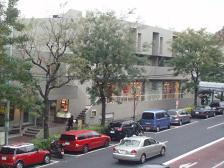
元倉眞琴さん ヒルサイドテラスB棟2階のオフィス前で
Mr. Motokura in Front of His Office at Hillside Terrace B (2nd floor)
12月8日(金)午後2:00にヒルサイドテラスB棟にある元倉さんのオフィスに伺い、代官山に関連する幅広い活動についてゆっくりお話しをお聞きしました。
元倉さんは、代表的な著作のタイトル「集まって住む」ことをライフワークとして追及している建築家といえます。この「集まって住む」という発想は、元倉さんが育った東京台東区の「下町」で見られるような色々な人が集まり助け合って生活している町のあり方から自然に出てきたもので、それを建築という専門分野の視点から実現しようと努力されてきました。
元倉さんが代官山を最初に訪問したのは1960年代末のまだ学生の頃で、完成したばかりのヒルサイドテラスA・B棟の白い建物がまだ牧歌的な周辺をバックに際立っていたことが今でも印象に強く残っているとのことです。大学卒業後、縁があって槙文彦設計事務所に入り、ヒルサイドテラスのその後の設計(特にD・E棟およびAnnex)などに携ることになりましたが、その際に槙氏の「まち」の視点から建築を考える姿勢が自分の信条に合うことで意を強くし、それが独立して設計事務所を構えられた後も大きなバックボーンになっています。
『集まって住む』:http://www.bk1.co.jp/product/2544549
元倉さんはこのような視点から、最近の代官山の動向に対して大きな危機感を持っています。2000年のアドレス完成前後から、それまでのゆっくりとしたヒューマンスケールの望ましい町が、再開発による商業化・高層化の波に飲み込まれ消費され尽くして、後には何も残らなくなるのではないか。特に問題なのは、人がマンションなどの建物の中にこもって町や通りに出てこなくなることで、そのために望ましいコミュニティが崩壊していくことを心配しています。
そのような動向をどうしたら逆転できるかが大きな課題で、そのヒントは元倉さんの原点である下町の長屋や町屋にあるといえます。そのような昔の暮らし方から学んで、いかに代官山の「まち」における人々の生活と交流のコミュニティを再生させるかを建物家として探求しているとのことです。
その点で、同じ「コミュニティの崩壊と再生」というテーマで元倉さんがかかわっているのが、東北芸術工科大学が支援しているプロジェクト「あたらしいがっこう」です。これは東北のある集落のコミュニティが少子化による廃校によって崩壊した状況を何とか救うために、閉鎖された校舎を「だれでも教えてだれでも学べる学校」というコンセプトで、集落の住民全員がかかわれるような場にすることによりコミュニティを再生させようという試みです。色々なイベントを行なったり、ギャラリーとして利用するなどの工夫をして住民に認知されてきているとのことです。ある意味では、これは代官山におけるヒルサイドテラスのコミュニティ活動と通じるものがあるようです。
コラム「あたらしいがっこう」:
http://www.tuad.ac.jp/community/backnumberfiles/05-01/column/column.html
元倉さんが見るところ代官山の今後の課題は、まちづくりをリードする人たちのつながりをどのように維持・拡大していくかで、これまでは同じ大学出身の仲間意識が潤滑油としてうまく機能してきたが、今後ともそれが続くかどうかという疑問を呈しています。これからはオープンな代官山コミュニティに参加してくる人たちと意見交換して優れた考え方を育て、代官山からさらなる知的な発信をするような場、つまり「あたらしいがっこう」をどうしたら作ることができるかが問題です。
その点で、元倉さんが中心となって運動した結果、重要文化財として保存することが決まった「旧朝倉邸」の将来の利用に関する一つの可能性として、そのような知的な活動の拠点とすることがあるかもしれないと、元倉さんは希望を述べられていました。
代スキ会「旧朝倉邸と庭園の将来を考える会」:
http://www.daikanyama.ne.jp/activities/asakura2/index.html
インタビューを終えた帰り道に、「いろいろとゆっくりお話しできてよかったです」という別れ際の元倉さんの暖かい言葉がいつまでも耳に残るとても心地よい代官山の午後の時間でした。
元倉さんのホームページ:
http://www.jcarb.com/KenchikukaShousai_9501630.html
スタジオ建築計画のウェブサイト:
http://www.kenchiku-keikaku.com/
I visited Mr. Motokura’s office at Hillside Terrance B around 2pm on December 8, and interviewed him on his wide-ranging activities about Daikanyama.
Mr. Motokura is an architect who is searching for what the title of his representative book, “Living Together,” means as his lifework. This concept, “Living Together,” naturally grew out of his childhood experience of living collectively with various kinds of people who were supporting each other as neighbors in the “shitamachi” area of Taito-ku, Tokyo, and as an architect, he has since been trying to realize this concept from the architectural standpoint.
Mr. Motokura visited Daikanyama for the first time in the late 1960s, when he was a college student, and still vividly remembers the white structure of the newly built Hillside Terrace A & B against an old residential background. After graduation, he joined Maki Architecture/Design Office and worked on the design for Hillside Terrace D & E as well as Annex, where he could confirm his belief by learning Mr. Maki’s stance that architecture should be approached from the viewpoint of community development. This belief has become a strong backbone for Mr. Motokura’s work since he opened his own office.
Makoto Motokura, “Living Together”:
http://www.bk1.co.jp/product/2544549
From this viewpoint, Mr. Motokura has a sense of crisis about recent developments in Daikanyama. His concern is that this city might be overwhelmed by the tide of highrise commercial development, destroying the community of the human scale, which had been fostered gradually until the construction of Daikanyama Address in 2000. Especially problematic is the fact that the desirable community is disintegrating because residents lock up themselves inside condominiums/apartments and do not go out to see each other on the streets in their community.
How to reverse this trend is a big challenge for everyone and, according to Mr. Motokura, some hints might be obtained from his original experience of collective living in “nagaya” or “machiya.” By learning from such traditional living style, he is trying to revive the community of human life in Daikanyama as an architect.
With regard to the theme “disintegration and revival of a community,” Mr. Motokura also is being involved in a project, “New Schooling,” supported by Tohoku University of Art and Design. This is an experimental project to revitalize a rural community by utilizing a closed school building for all community members to be involved in teaching/learning activities regarding community matters, where Mr. Motokura has helped them organize various events and open a gallery. This seems somewhat like community activities often held at Hillside Terrace.
Makoto Motokura, “New Schooling”
(TUAD On-Line Community Magazine):
http://www.tuad.ac.jp/community/backnumberfiles/05-01/column/column.html
As Mr. Motokura sees it, a challenge for Daikanyama is to keep and expand the network of community leaders in the future. For this purpose, Daikanyama may need its own “New Schooling,” where community leaders can interact with newcomers for mutual learning to nurture creative ideas.
In this connection, Mr. Motokura has been quite active in the movement to save and maintain the old Asakura residence, which was recently designated as an important cultural asset by the government, and intends to propose its possible use as a center for teaching and learning, that is “New Schooling,” for the Daikanyama community.
Daisuki-Kai “Movement for the Future of the Old Asakura Residence and Garden”
http://www.daikanyama.ne.jp/activities/asakura2/index.html
Mr. Motokura’s Homepage:
http://www.jcarb.com/KenchikukaShousai_9501630.html
Website for Studio Kenchiku Keikaku:
http://www.kenchiku-keikaku.com/
インタビュー(7)鈴木さん・岩橋さん:Interview with Mr. Suzuki/Mr. Iwahashi [インタビュー]
インタビュー:鈴木正慶さん(中部大学教授)・岩橋謹次さん(アスピ代表)
Prof. Masayoshi Suzuki (Chubu Univ) & Mr. Kinji Iwahashi (ASPI)
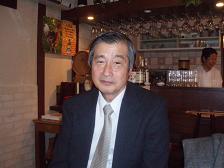

@ル・ビストロ・パッション:http://www.pachon.co.jp/jpn/bistro_broche/
12月8日(金)に、たまたま1週間前の「挑戦者たちの忘年会」(本ブログ12月1日の写真参照)の立役者である鈴木さんと岩橋さんが会ってランチを共にされる場に参加する機会があったので、その際の会話を以下インタビュー要旨という形でまとめてみました。
お二人の関係はそもそも大学時代にまでさかのぼるそうで、岩橋さんは「特に代官山に来て以来、鈴木さんにはいつも背中を押されて仕事をしてきた」といわれています。特に岩橋さんのコンサルタントとしての仕事の看板になっている「チェンジ・エージェント」(Change Agent)という言葉は鈴木さんからいただいたとのことです。
「アスピはチェンジ・エージェント」:http://www.aspi.co.jp/page2-1.htm
他方、鈴木さんは、岩橋さんの代官山に対するスタンスやポリシーが最初から今日にいたるまで一貫しており、まったくぶれないことを高く評価しています。鈴木さん自身は、日本経済の将来を背負って立つ独創的な起業家を育てる仕事を長年続けており、それも「ものづくり」の伝統がある中部地方を拠点として、地に足の着いた新規ビジネスを立ち上げる若者を支援することを続けてきたそうです。その結果、先日の忘年会の参加者のように、新しいビジネスで頭角をあらわす次世代の起業家が出てきたことは嬉しいかぎりです。
ただし鈴木さんによれば、日本の問題点は個々人が能力的に優秀でも、世界の舞台でグローバルなルール作りに参加できる人材が少ないことで、これはビジネスの世界でも、鈴木さんが学生時代から続けている柔道などのスポーツの世界でもいえるとのことです。
(鈴木さんの社会活動:各種ベンチャー企業顧問・社外取締役、財団法人全日本柔道連盟委員)
http://www.chubu.ac.jp/about/faculty/profile/e61369f0f7753994661780584e71a6d7f36e2685.html
今後の代官山の課題としては、この街を真の意味で「エクセレントなセンター」(COE)、つまり創造的なクラスターにするために次世代のリーダーを育てることで、そのために先日の忘年会のように異なる世代や異なる分野のメンバーが自由に交流する場を代官山に作ることであるという点で、鈴木さんも岩崎さんも意見が一致。実際に、それぞれの分野で確立した先輩方のほんの一言が、次の世代の若者にとっては大きなヒントや励みになるものです。ある意味で、鈴木さんと岩橋さんの関係もそれに似たものがあったのかもしれません。
以上、ほんの1時間ほどでしたが、代官山でなければ得られない美味しい食事と和やかな雰囲気と生産的な会話を心行くまで堪能したランチタイムでした。
On December 8, I happened to join Mr. Masayoshi Suzuki and Mr. Kinji Iwahashi, who both were main host figures for last week's "year-end party" (see this blog for Dec. 1), and had lunch together in Daikanyama.
Their close relationship dates back to their college days, and Mr. Iwahashi says "I have been pushed forward by Mr. Suzuki since I started working in Daikanyama." For example, Mr. Iwahashi has adopted as the key word for his consulting business, "Change Agent," which was originally given to him by Mr. Suzuki.
"ASPI is Change Agent":http://www.aspi.co.jp/page2-1.htm
On the other hand, Mr. Suzuki highly appreciates Mr. Iwahashi's consistent stance and policy toward the Daikanyama community. Mr. Suzuki himself, based in the Chubu region, has long been supporting young entrepreneurs with original ideas, while emphasizing non-nonsense approaches in the tradition of creative manufacturing in the region. He is glad to see an increasing number of next-generation entrepreneurs appearing on the business scene, as we met at last week's year-end party.
His concern, however, is the fact that there are very few Japanese who can participate in rule-making activities in the international community, whether it is business or sports like Judo, which Mr. Suzuki has been practicing since his student days.
(Mr. Suzuki's volunteer activities: consulting/outside directors for venture business, and committee member, All Japan Judo Federation)
http://www.chubu.ac.jp/about/faculty/profile/e61369f0f7753994661780584e71a6d7f36e2685.html
In conclusion, Mr. Suzuki and Mr. Iwahashi agreed that a challenge for Daikanyama would be to foster and train next-generation leaders for this community to be a "Center of Excellence" (COE), or a creative cluster, and to provide a place in Daikanyama for free networking meetings of various members with different backgrounds in different generations, as seen at last week's year-end party. In fact, just a few words by well-established senior people could mean a lot to young junior members in their respective fields. In a sense, that might be the essence of the relationship between Mr. Suzuki and Mr. Iwahashi themselves.
Although it was just a matter of an hour or so for lunch, I fully enjoyed the good food, nice atmosphere, and productive conversation, that would be only possible in Daikanyama.
インタビュー(5)大熊喜昌さん: Interview with Mr. Okuma [インタビュー]
インタビュー:大熊喜昌さん(都市計画家協会理事、代スキ会理事)
Interviewee: Mr. Yoshimasa Okuma (Trustee, Japan Society of Urban & Regional Planners, and Trustee, Daisuki Kai)


大熊喜昌さん 自宅前で:Mr. Yoshimasa Okuma in Front of His Home
11月9日(木)午後2:00に青葉台2丁目の大熊さんの自宅に伺い、代官山の街づくりについてのご意見をお聞きしました。
「代官山に住んだきっかけ」
大熊さんは東京・番町の生まれですが、大阪にしばらく滞在し、その後1960年代後半に東京に戻って千駄ヶ谷に建築・設計関係の仲間4人と当時としては先駆的なコーポラティブ住宅を作って20年ほど住んでいたそうです。それが今から7年ほど前に青葉台2丁目の旧山手通りに隣接した土地を入手して、奥様の設計で今の自宅を建てて今日に至っています。代官山エリアを選んだ理由の一つは、この地域に古いお屋敷が多くうっそうと木が茂った閑静な住宅街のよさが残っていたからとのことです。また中学生の頃、番町から鉢山にある元ノースウェストの寮のあたりに英会話を習いに来ていたという思い出もあったようです。
「代スキ会での活動」
大熊さんは代官山に来て、「賃貸都市」という概念に興味を持ち、「ヒルサイドテラス」でそれを実践している朝倉さんと知り合い、また代官山のよさを守る運動を進めている石原さんや、また渋谷再開発の市民会議では野口さんといった「代スキ会」のキーメンバーと会って交流するうちに、いつの間にか「代スキ会」の理事にされていたとのこと。また岩橋さんを中心にヤマハのパッソルに乗る「エコパト隊」が結成された際に、乗り物に乗らない大熊さんは、歩いて代官山の価値を見出す活動として「お散歩隊」を組織して隊長(ガイド)として活躍。また代官山の歴史を研究する加藤東海大学教授と協力して地域特性を表示した「代官山マップ」を作成し、その活動が代官山の街づくりをドキュメントするDVD作りの動きにつながっているようです。
参考:代スキ会お散歩隊隊長の活動:
http://www.daikanyama.ne.jp/topics/05060301/topics.html
「街づくりのやり方」
大熊さんは「街づくり」について、単に規制的な計画やルールを作ればよいというわけではないと主張しています。規制となると日本では行政があらかじめ数字などの基準を作り、開発業者にすべての数字的な情報を出させた上で、許可するかしないかを決めて終わりになります。そこには英米流の都市計画にあるような交渉や調整の余地があまりないのが特徴です。
これは日本では必ずしも専門家でない行政が中心となるのに対して、英米では地域ベースの協議会などで専門家が自信をもって開発の計画内容を審査して、開発者と交渉を行ない、地域に望ましい形に調整した上で、行政にアドバイスし、行政もそれを尊重するという協力体制が出来ているからとのことです。日本でもそのような街づくりの体制の整備が望まれますが、どうも街全体を望ましい形でコントロールするという発想も手法も欠けている点が日本の問題で、それがまさに代官山のような街づくりを進める上で、大きな障害になっていると大熊さんは言います。
「望ましい代官山のあり方」
大熊さんが代官山に住んでみて気づいたのは、色々な人が交流する機会が非常に多いという点で他の町にはない特長があるということ。それは30年以上もかけてゆっくり自然に街づくりをしてきたために多種多様な人がそこに住みついて程よいスケールでバランスのとれた「アーバン・ヴィレッジ」を形成した結果で、それには「ヒルサイドテラス」の開発が大きな影響を与えたことは誰もが認めるところです。
しかし代官山は現在「バブルの時代」から一周遅れの再開発の波に襲われており、そのため残り少ない古い屋敷などのまとまった敷地がファンドやデベロッパーの手に渡り、高層のマンションやオフィスビルなどへの建て替えの計画が次々と進んでいるようにみえます。大熊さんにとってなつかしい鉢山の元ノースウェストの寮があった地区も大きく変貌しつつあります。それを事後的な交渉で阻止しようとしても難しいので、それを事前にチェックするような街づくりのあり方が必要です。
ただし、すでに述べたようにそれが単なる規制ではなく、その地域の真の価値を高めるような望ましい開発になるように地域主導の協議会がチェックし、交渉して調整できるようにすべきです。実際に、このところ「街づくり条例」のもとで各地域の意見や運動が尊重され、「わがまちルール」などが制定できるようになってきています。代官山でも「代スキ会」が渋谷区によって代官山の街づくりの協議会として正式に認定されたこともあり、今後は望ましい方向にできるだけ早く進んでいくように住民がコンセンサスを形成して皆が協力することが大切と、大熊さんは結論づけています。
参考:大熊さんのプロフィール:
http://www.topicserv.com/telepac/dtdisp.asp?no=13
著書:
『建築計画・設計シリーズ20―街なみ・街づくり』(共編著、市ヶ谷出版)
『密集市街地のまちづくり―まちの明日を編集する』(共編著、学芸出版社)
http://bookweb.kinokuniya.co.jp/htm/4761522976.html
I visited Mr. Yoshimasa Okuma’s home in Aobadai 2-chome and interviewed him regarding community development in Daikanyama in the afternoon on November 9. The following is a summary of the interview:
Why did Mr. Okuma choose to live in Daikanyama in the first place? He was born in Bancho (Tokyo) and spent some time in Osaka. Then he built his own “cooperative” house with his colleagues in Sendagaya in the late 1960s, and lived there for about 20 years, before moving to Daikanyama seven years ago. The main reason why he chose Daikanyama was because he liked the quiet atmosphere of old residential quarters with a lot of trees remaining in the neighborhood around that time.
Soon after he settled in this town, Mr. Okuma got to know Mr. Asakura, Mr. Ishihara, Mr. Noguchi, Mr. Iwahashi, and other key members of “Daisuki-kai,” which he himself somehow got involved in. In particular, Mr. Okuma organized a walking-tour group, “Osanpo-tai,” to find Daikanyama’s community value in various neighborhoods. He also helped develop the Daikanyama map by working with Tokai University Professor Kato, leading to a current DVD project on the history of the Daikanyama community.
Reference: “Daisuki-kei Osampo-tai Activity”:
http://www.daikanyama.ne.jp/topics/05060301/topics.html
Regarding how to develop desirable communities, Mr. Okuma emphasized that regulatory planning and rules would not be enough. Especially in Japan, regulations often mean simple administrative decisions based on numerical standards with no room for negotiation or adjustment as in the case of urban planning in Western societies.
This is a result of bureaucratic administration with not much expertise in urban planning in Japan, in contrast to the American or British style community development, where a selected group of urban planning specialists as community-based council members examine proposed development plans and negotiate with developers and local governments, if necessary, for the benefit of their community.
How to keep Daikanyama as a livable community? Mr. Okuma has found this town very special in that various kinds of people are living and interacting with each other, forming a well-balanced “urban village” on the human scale, where the Hillside Terrace developments have had great impacts.
Nowadays Daikanyama is undergoing rapid change facing the tide of redevelopment, and old residential quarters and premises are being bought up by developers and investment funds, which tend to plan highrise office buildings and condominiums. So, it is urgent to install some mechanism to examine and screen proposed development plans “ex-ante,” and not “ex-post.”
According to Mr. Okuma, however, simple regulations would not be good enough to maintain and improve the quality of the community, and local residents’ involvement should be encouraged in urban planning and community development. Actually, the “Community Development Ordinance” has recently been introduced so as to allow local communities to adopt “My Town Rules” as guidance for local administrative actions. In the case of Daikanyama, “Daisuki-kai” has officially been designated as a community council to adopt such rules in the future. In the meantime, it is important to form consensus among residents to work together for a better life in this community.
Reference: Mr. Okuma’s Profile:
http://www.topicserv.com/telepac/dtdisp.asp?no=13
インタビュー(4)朝倉健吾さん:Interview with Mr. Asakura [インタビュー]
インタビュー:朝倉健吾さん(朝倉不動産専務取締役)
Interviewee: Mr. Kengo Asakura (Director, Asakura Real Estate)
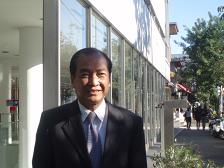
朝倉さん ヒルサイドテラスの前で:Mr. Asakura in Front of Hillside Terrace
11月7日(火)午後2:00に代官山ヒルサイドテラスのインフォメーション・ルームで朝倉さんとお会いして、朝倉さんが長い間代官山と付き合い、ヒルサイドテラスの建設と運営にかかわってこられたスタンスについてお聞きしました。以下は朝倉さんのお話しをできるだけ正確に伝えるために、朝倉さんを一人称とする引用の形式でまとめたものです。
(朝倉さんのお話し)
「不動産業とはどうあるべきか」
私はいつも「不動産業」とは何かということを考えています。通常「不動産屋」は商業的にもうけることが前提で、金銭的な利益を求めますが、それはよい街づくりとは別ものです。本当の街のよさとは、住民にとっての快適さであり、住みごこちのよさであるべきで、それはその街に長く生活した人が感じるものです。したがって、不動産業も長くやってそのよさを実現し促進していくべきものではないかと思います。私どもはささやかながらそれを代官山でヒルサイドテラスの開発と運営という形でやってきたのですが、しかしそれを一事業者だけで全部やろうとしても無理なので、そこに住む人たちが皆で協力して支え合っていかなければなりません。
「再開発による代官山の変容」
代官山ではこれまで長い時間をかけて住民にとってよい街づくりが進んできたのですが、ここ数年は現実に大きな再開発の波が襲ってきており、このままでは代官山のよう低層で住みやすい環境の街も大きく変容してしまう危険があります。それに対して、私たちは「代スキ会」などを結成して、開発者側と交渉を重ねて何とか異常に高層な開発をチェックすべく運動してきました。しかしそれにもかかわらず、代官山プラザのような高いビルが建ってしまうはとても残念です。ただし、その過程で、開発計画の多少の調整や様々な情報の交換などが進み、多少風通しがよくなったのではないかと思います。
「説得力のある裏づけが必要」
しかし、そのような開発に反対するという形が本当によかったのかどうかは分かりません。対立的な形をとらずに説得力を持つために、本来なぜ高層の開発がだめか、またなぜ低層なら価値が上がるのかを示す裏づけがあるべきで、低層でもよりよい開発なら業者にとっても住民にとっても利益が上がり、自ずから望ましい妥協点が見つかって、よい街づくりにつながるはずです。例えば代官山アドレスの再開発についても、再開発されることは必然でしたが、それを単なる高層の開発にしてしまったのは代官山のよさを生かしきれなかったといわざるを得ません。もっと代官山らしいものを作っていたら、もっとよい話題づくりになり、もっと本来の価値が上がっていったのではないでしょうか。
「代官山らしさとは何か」
それでは「代官山らしさ」とは何でしょうか。それはよく「スローライフ、ヒューマンスケール、スローアーキテクチャー」などといわれていますが、重要なことは時間をかけてゆっくりとよいものを見分けて作り上げていくという点にあります。ヒルサイドテラスを設計された槙文彦さんも、時間をかけて作ったことに価値があると言われています。私としては、時間をかける意味は、長くこの街に住んで生活している人たちにとって何がよいものかということが重要で、それはなかなか理論的な分析にはなじまないものです。したがって、私はこれまで不動産業の経営も歴史によって培われた自分の直感や感性に素直にしたがって行ってきたのですが、その結果が時間を経てよいものを残すことにつながったと自負しています。
「まだ理想には程遠い現実」
ただしそれはある意味で自分勝手なので、外に対して基準やルールが分かりにくいために、代官山のよさがこれまで十分に生かしきれてこなかったきらいがあることも認めなければなりません。理想をいえば代官山のよさは、代官山に住んでいる人たちが集まってイベントを開き、自由に交流し、そこからさらによいものを引き出していけるような環境を作ることです。そのためにささやかなお手伝いをヒルサイドテラスのホールなどを提供して行ってきました。しかしそれはまだ不十分で、代官山のよさを十分に引き出すには至っていません。
「今後の取り組むについて」
そうしている間にも再開発の波が押し寄せてきてハード面でも破壊的な動きが進みつつあります。何とかこの事態を乗り越えるとともに、代官山をとりまくより広い地域にも目を向けて長期的に代官山のためになるような運動につなげられればと希望しています。具体的には渋谷駅周辺の再開発で、それについては私も渋谷区の会合などで意見を述べて、渋谷らしいよい開発をすべきと主張しています。何とかそのような努力が代官山の将来のために役立ってほしいと願うばかりです。
(筆者の感想)
以上のまとめに特に付け加えることはありませんが、言葉の端々に朝倉さんの本音を聞けたことがむしろ収穫でした。それは「何といっても先祖から相続したこの代官山の不動産を減らさずに維持していくだけでやっと」という朝倉家の一員としての本音と、「ヒルサイドテラスこそ代官山そのものである」という「ヒルサイド族」の中核メンバーとしての自負心といえます。朝倉さん抜きに今日の代官山らしい代官山は考えられませんし、代官山らしい代官山抜きに今日の朝倉さんは考えられません。その状況が大きく代わりつつある現状に危機感を覚える朝倉さんの気持ちがひしひしと伝わってくるインタビューでした。
参考文献:
朝倉家の歴史について:
「ヒルサイドテラス物語―朝倉家と代官山のまちづくり」
http://bookweb.kinokuniya.co.jp/htm/4773802170.html
ヒルサイドテラスのHP:
http://www.hillsideterrace.com/
I interviewed Mr. Kengo Asakura in the Information Room at Daikanyama Hillside Terrace from 2:00 pm on November 7. The following is a brief summary of what Mr. Asakura said.
“What is real estate business?”
To Mr. Asakura, “real estate business” should mean something not to seek commercial profit only, but to realize and sustain a desirable community for long-time residents. However, it cannot be done by one real estate agent alone, but should be supported by all residents in the community.
“Changing neighborhood in Daikanyama”
A recent boom in urban redevelopment seems to turn the character of the Daikanyama community for the worse, if it is left unchecked. So, Mr. Asakura helped organized a community movement to negotiate with developers and, as a result, succeeded in modifying the plan and attitude of developers to a certain extent.
“Persuasive argument needed”
However, the conflicting relationship between developers and residents is not really desirable. Rather, we should be able to persuade developers so as to find a compromise to benefit everyone including developers and residents, resulting in a lower density development with higher value than otherwise.
“What is Daikanyama-style?”
Daikanyama-style often means “slow life,” “human scale,” “slow architecture,” etc., and Mr. Fumihiko Maki, who designed Hillside Terrace, said the value of Hillside Terrace stems from the time we have spent with the community and residents. Mr. Asakura has relied on the intuition and feelings that he has nurtured with the history of Daikanyama in managing Hillside Terrace, leading to a desirable community for residents.
“Efforts toward ideal community”
Mr. Asakura admits that more transparency and efforts are needed to realize Daikanyama’s full potential, where all residents can participate in various events and interact with each other to create a better community for themselves. That is what Mr. Asakura originally had in mind in offering a kind of public space such as halls at Hillside Terrace.
“Challenges and prospects”
In the meantime, destructive waves of redevelopment appear to be approaching and we need to face up to this challenge by making all kinds of efforts for the sake of the Daikanyama community. These days Mr. Asakura is giving advice to Shibuya for redevelopment of the Shibuya-station area, based on Daikanyama’s experience, and thus indirectly helping maintain the desirable environment of the greater Daikanyama region.
Throughout the interview, I vividly felt Mr. Asakura’s sense of crisis in maintaining the property that he inherited and the leadership that he has been taking in Daikanyama, which is now being threatened by a current redevelopment boom.
インタビュー(3)石原貞治さん:Interview with Mr. Ishihara [インタビュー]
インタビュー:石原貞治さん(ICAデザイン研究室取締役)
Interviewee: Mr. Sadaharu Ishihara (Director, ICA Design Institute)
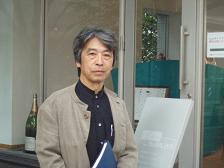
石原貞治さん ヒルサイドカフェの前で:Mr. Ishihara in Front of Hillside Cafe
10月19日(木)午後2:00に代官山ヒルサイドカフェで石原さんとお会いして、これまで石原さんがかかわった代官山の住民による活動の歴史と今後の展望についてお聞きした。
最初に石原さんが住民の一人として代官山の街づくりにかかわったのは、約20年前に代官山駅の踏切をなくす動きに反対する住民の運動に参加し、その際に出てきた駅廃止の噂に対して皆で代官山を利用しようという「駅復旧を促進する会」を立ち上げ、1600人ほどの会員を集めたこと。そこで学んだのは、重要なことは単なる反対運動ではなく、住民が自分の街全体のあり方を考えることで、この活動がきっかけで代官山の町会の役員にならざるをえなくなったとのことです。
その後、2000年になって代官山アドレスがオープンし、さらに八幡通りに総合設計制度で(区の補助金を使って)高層の代官山プラザビルが計画されるに至り、それが景観を壊し都市機能を麻痺させることを訴える「代官山の良好な生活環境を守る会」を発足させ、街全体のあり方を考えて、自分たちで実態を調査し、あるべき姿を具体的に提案する運動を推進。その際に、地元の朝倉氏や東海大学の加藤氏を始め何人かのキーパーソンが協力してくれて、独自の調査と計画を練り上げたことが大きかったようです。
その結果もあって、代官山プラザビルの計画は26階から16階まで引き下げられ、不満ながら今後は住民が望ましいと思える真に社会的価値をもつ街づくりへの流れを強めることになる。実際に、その際の調査結果や計画案が、その後の「地区計画」、「町づくり条例」、「景観条例」などの制定の流れを先取りすることになり、その時の運動が後の「代スキ会」の前身となったとのことです。
参考:「代スキ会(代官山ステキな街づくり協議会)」
http://www.daikanyama.ne.jp/machi/
しかし、そのような運動はあくまで一部のリーダーが引っ張る「頭でっかちの反対運動」に過ぎないという意見が特に行政側で強かったこともあり、もっと住民が街づくりに参加し実感できることを考える「代官山タウンワーク」を結成。まずやったことは、ボランティアを集めた落書き消しで、それは実績が上がり、広く認知されることになりました。それと同時に、専門家や行政(渋谷区と目黒区)を巻き込んだ勉強会などを行い、地区計画や用途地域などを提案したり街づくりに関する要望書を提出したりしましたが、それについては当初は行政側のアレルギーや抵抗が激しかったとのこと。しかしそれも行政側の人や方針が変わって、最近ではスムーズに聞いてもらえるようになってきたようです。
参考:「代官山タウンワーク」
http://www.daikanyama.ne.jp/activities/townwork/
今後の課題については特に以下の二つの点が重要:
1)一番大切なのは望ましい街づくりのルールを作ることで、これまでの法律や計画はあくまで最低限守るべき条件にしか過ぎず、もっと地域のあり方に適合し、地域にとって積極的にプラスになるような街づくりのルールが必要。そうでないと近視眼的な経済合理主義の中で、地域がいろいろな面で空洞化し、結局は地域の価値が下がってしまう危険があります。
2)さらに住民が実感できる街づくりを進めることで、代官山はともすると何人かのリーダーにもとでばらばらなグループの活動が行われて街全体として必ずしも融合しないという問題があったので、それを乗り越えるような住民参加交流型の活動の推進が重要。そのために代官山坂の中央分離帯の土地でひまわりを育てる運動を行ったが、そのような皆が楽しい目的で集まって街を美しくするような活動を今後とも根気よく続けていきたいと、石原さんは熱く語ってくれました。
なお石原さんの研究所(ICAデザイン研究所)のホームページは以下の通り:
http://www.daikanyama.ne.jp/areaguide/database.cgi?equal18=301&tid=all_detail
I met and talked with Mr. Sadaharu Ishihara at Daikanyama Hillside Cafe from 2:00 pm on October 19.
Mr. Ishihara first participated in Daikanyama’s community movement when residents faced a possibility of abolition of Daikanyama train station in the mid 1980s. Then he learned that the important thing was not just to protest negatively, but to think positively about the whole community for the future.
In 2000, when Daikanyama Address was opened and another highrise development, Daikanyama Plaza Building, was planned, he helped organize a resident movement to protect Daikanyama’s good living environment. As a result of extraordinary efforts by some community leaders and many residents, who surveyed actual land use in Daikanyama and proposed a comprehensive community development plan, an important first step was taken to contain highrise development and to guide the future course of the community in the desirable direction for residents themselves. The movement then became the predecessor for “Daisuki-kai” (Council for Daikanyama’s Suteki Community Development):
http://www.daikanyama.ne.jp/machi/
In order to respond to some criticism against such movements and also to involve more residents directly, Mr. Ishihara helped launch a citizens’ volunteer organization, “Daikanyama Townwork,” where residents themselves voluntarily work for improvements in their own living environment. The first project was to erase graffiti on the wall in Daikanyama by organizing volunteers on a regular basis, and this was quite successful in attracting public attention to the movement of “Daikanyama Townwork”:
http://www.daikanyama.ne.jp/activities/townwork/
According to Mr. Ishihara, Daikanyama is facing the following challenges:
1) How to formulate a rule for everyone to honor beyond legal restrictions in order to increase its community value in the long run;
2) How to promote synergy among various group activities led by a few community leaders in order to involve residents more directly in community development movements.
For the latter purpose, he helped initiate a participatory beautification project to plant sunflowers in an open strip along Daikanyama-zaka, and that has turned out to be a success in mobilizing various kinds of residents in the community. Mr. Ishihara said he is now eager to launch another project of this kind in the near future.
インタビュー(2)野呂芳明さん:Interview with Mr. Noro [インタビュー]
インタビュー:野呂芳明さん(立教大学教授、代官山アドレス管理組合理事長)
Interviewee: Mr. Yoshiaki Noro (Professor, Rikkyo University;
President, Daikanyama Address Residents Association)
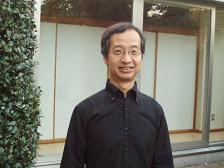
野呂芳明さん 同潤庵の前で:Mr. Noro in Front of "Dojunan"
10月16日(月)午後4:30ころ代官山アドレス内の落ち着いた茶屋風の和室「同潤庵」で、管理組合理事長の野呂さんとお会いして色々とお話しをうかがいました。
野呂さんは、社会学者として興味を持ったコミュニティに住み込んで住民と交流しつつ研究を進めるスタイルを大切にされており、2000年以来代官山アドレスに住んで、管理組合の仕事をされてきたのもそのような動機が多少働いたからとのことでした。特に再開発という事業について、建物というハード面もさることながら、そこに住む人たちがこれから新しく作り上げる共同体について研究をすると同時に何か手伝いができればと思われたそうです。
管理組合の仕事で苦労された問題は、(1)対内的には住民に当事者意識を持ってもらい、望ましいコミュニティを醸成して、お互いに折り合って問題解決をはかるようにすること、また(2)対外的には高層再開発がもたらす周辺地域との摩擦をやわらげて、アドレスを地域社会の中に定着させていくことで、これらの問題は少しずつ解決に向かっているとのことです。
例えばアドレスの町内会が周辺の町内会と協力して夏祭りのおみこしや山車を運行したり、ちょうちんの飾りについて周辺の商店街とも協力して進めるなど、地域社会に入り込んで認知されてきた。またアドレスのコミュニティ・スペースや倉庫のスペースなどを周辺の町内会にも開放してサービスを提供したことも相互に理解を深めることに役立ったとのこと。
ただし、課題はいかに代官山全体でビジネスを始め色々な人の集まりや活動レベルを上げるかということで、ここ数年商売が不振になってきており、昨年春にアドレス内にあった地域の拠点ともいえるスーパーが撤退するなどの問題が生じている。したがって、今後はアドレスの中の広場を活用してイベントを行なったり、商店街主催で人が集まる仕掛けを考えていく必要があり、代官山全体としてもっと発信を強めていきたとのことでした。ここ数年やっているクリスマスのイルミネーションを今年は少し早めに代官山全体の風物詩になるように工夫するなりといった、広がりを演出する仕掛けがその一例かもしれません。
最後に代官山の長期的な展望については、最近トレンドとなった超高層の大規模再開発と違い、代官山にはこだわりをもった人たちが集まり、何らかのライフスタイル情報を発信している点が財産なので、それをさらに引きだしてネットワークを作っていけば将来は明るいのではないか。そのために現在若い人を巻き込んだ勉強会を開いており、色々な提案も出てきているとのことでした。
この野呂さんとのインタビューによって、私自身これまで外からしか見ていなかった代官山アドレスの中の人たちの考え方や感じ方が少し分かった気がして、代官山全体をコミュニティとして見る発想がより身近に感じられるようになりました。代官山の将来はまだまだ明るいと確信した次第です。
なお野呂さんの代表的な著作「生きがいの社会学」については以下を参照ください:
http://www.koubundou.co.jp/books/pages/kbn3653.html
「代官山アドレス」について:About Daikanyama Address:
http://www.17dixsept.jp/web/about/
I interviewed Mr. Noro at a tea room, Dojunan, inside Daikanyama Address from 4:30pm on October 16. He has been a resident of Daikanyama Address since its opening in 2000, partly because he was interested in living in a community that he would like to study as a sociologist.
As president of the residents association, he has been trying to deal with the following problems:
1) Internally, how to encourage residents to interact actively with each other to form a real community for collective problem-solving;
2) Externally, how to reduce tension (caused by highrise development) with neighboring communities and be recognized as a member of the greater Daikanyama community.
These problems are gradually being resolved by cooperation with other town associations (“Chonai-kai”) in the "Bon" festival and Christmas seasons, and also by offering open space and facilities for neighboring community needs.
A serious challenge for Daikanyama is how to revitalize business and social activities by strengthening relations and interactions among businesses, residents, and visitors. There should be a bright future for Daikanyama, if new ideas and means can be found to mobilize the excellent human resources that already exist in this community, according to Mr. Noro.
About "Daikanyama Address":
http://www.emporis.com/en/wm/cx/?id=115148
インタビュー(1)鈴木幸生さん:Interview with Mr. Yukio Fujita [インタビュー]
インタビュー:鈴木幸生さん(株式会社スーパープラニング専務取締役)
Interviewee: Mr. Yukio Suzuki (Executive Managing Director,
Super Planning Co.,Ltd. Tokyo Office)

藤田香織さん(Kaori Fujita)と鈴木幸生さん(Yukio Suzuki)
10月3日(火)午前10:30に代官山アドレスの近くにある鈴木さんのオフィスに伺いました。
まず、鈴木さんの会社は生活・ファッション雑貨のデザインとプロデュースを専門に行なっており、特にOLや主婦がカジュアルに持ち歩くトートバッグに力を入れていて、実際に代官山エコバッグもプロデュースしたとのことです。またトートバッグのデザインを地域のデザイナーから募集して、10月10日の「トートバッグの日」にグランプリ作品を選んで表彰しています。これは地域のデザイナーを育てることを目的とした社会貢献活動で、過去の受賞作品など詳しくは以下を参照:
http://www.superplanning.co.jp/rootote/designaward/
さらに鈴木さんが支援しているFRIENDLY DAY INTERNATIONAL代表の藤田香織さんを紹介していただき、いろいろな地域ボランティアー活動についてうかがいました。主な活動は「414フレンドリーデー」で、これは4月14日をフレンドリーデー、つまり「友だちの大切さを想い、人も動物も自然も仲良しでいたいと願う日」と指定し、さまざまな活動やイベントを行なうもので、今年の4月にも代官山で、インスタレーション展示、音楽ライブ、ギャラリー展覧会、エコバッグ・プロモーション販売などのフレンドリーデー活動を企画したとのことです。詳細は以下を参照:
http://www.friendlyday.org/
今やこの「フレンドリーデー」のアイデアは、カンボジア、ベトナム、フィリピンなどのアジア諸国に広がりつつあり、国際的な共同プロジェクトも計画されているようです。
最近もっとも力を入れているのが、「リユースTシャツ」プロジェクトで、これはいらないTシャツを集めて裏返しにして、新しいデザインをほどこすもので、使わないTシャツ3枚と「リユースTシャツ」1枚を物々交換するプロジェクトを通じてTシャツ集めに努めているとのこと。9月29日付の「読売新聞」にも取り上げられ、広く注目を集めています。詳細は以下を参照:http://blog.livedoor.jp/friendlyday414/
今後とも文化と環境を重視したボランティア交流活動を通じて代官山に貢献したいと藤田さんは語っていました。代官山独特の文化が、鈴木さんや藤田さんのようなボランティア精神にあふれた人によって支えられていることを実感したインタビューでした。
I visited Mr. Suzuki at his office near Daikanyama Address around 10:30 on October 3.
First, he explained that his company specializes in planning and producing life/fashion accessary goods, especially nicely designed totebags for working women and housewives to carry on casual occasions. In fact, the Daikanyama Ecobag was designed and produced by his company, and totebag design awards are presented to encourage community artists to use totebags as their canvas for fostering artistic creativity in the community. For the past awards, see the following:
http://www.superplanning.co.jp/rootote/designaward/
Then Mr. Suzuki introduced me to his associate, Ms. Kaori Fujita (FRIENDLY DAY INTERNATIONAL), who seems quite active in voluntary networking projects such as "414 Friendly Day," organizing various activities and events on April 14, when installation work presentations, live music sessions, gallery exhibitions and eco-bag promotion sales were held in Daikanyama. For more details, see the following:
http://www.friendlyday.org/
The Friendly Day concept is spreading to other countries such as Cambodia, Vietnam, the Philippines and other Asian countries, and international collaboration is now being planned.
One of the most recent projects is "renewal T shirts with new design printed inside out," and barter trade between one renewal T shirt and three unused T shirts. For this "3 for 1 T shirt project," see the following:
http://blog.livedoor.jp/friendlyday414/archives/50535225.html
Ms. Fujita seemed eager to contribute more to Daikanyama through her voluntary networking activities with emphasis on culture and ecology. This interview made me realize that the Daikanyama culture is supported by people with volunteer spirit like Mr. Suzuki and Ms. Fujiita.



